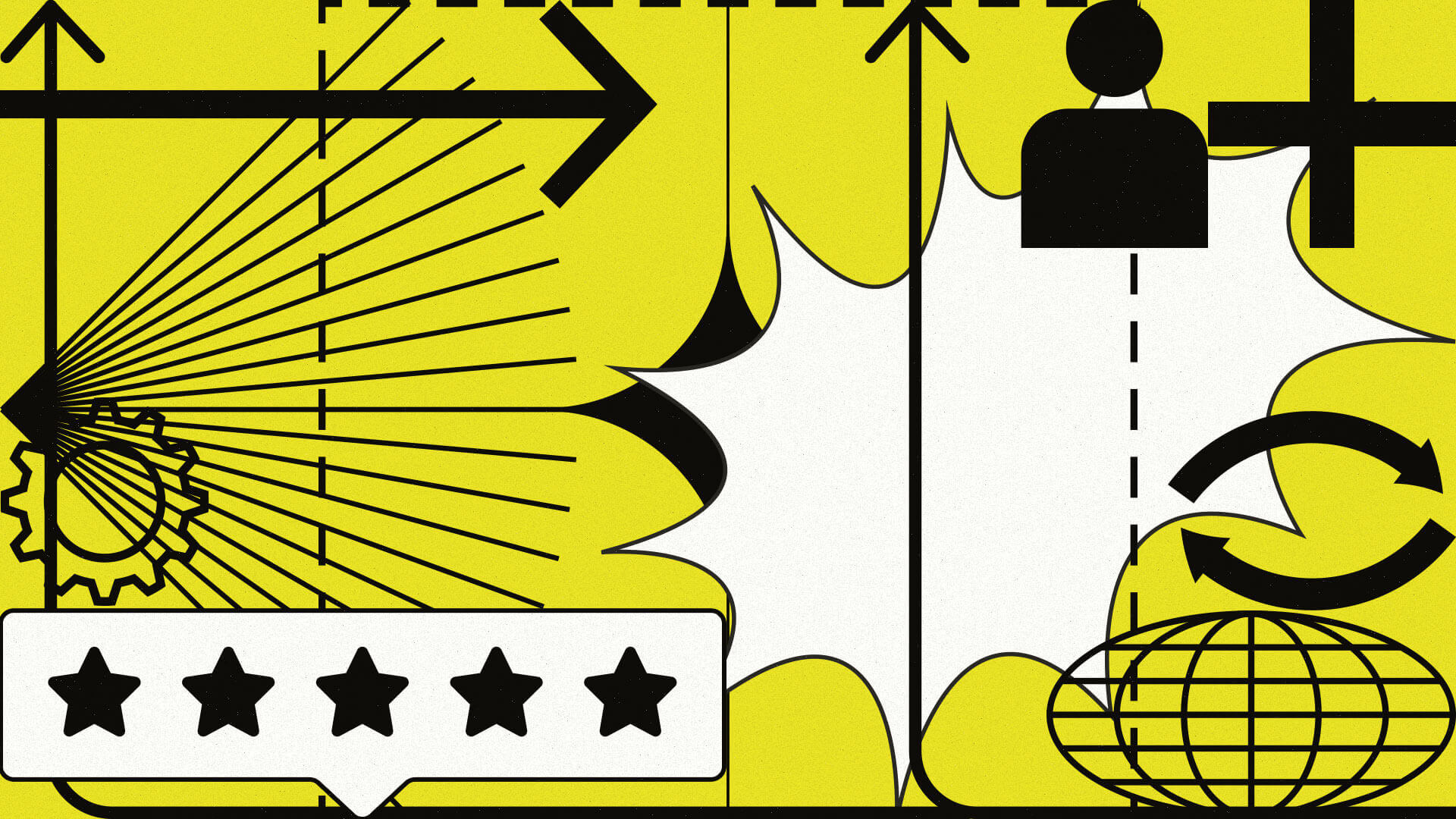The pulse of any thriving business is the steady beat of loyal customers. Like the heart pumping life-giving blood to the body, customer loyalty infuses vitality into both fledgling start-ups and seasoned enterprises.
This loyalty can be the difference between a business soaring to new heights or plummeting into obscurity.
Now, imagine cracking the code that turns one-time buyers into lifelong advocates for your brand. It would surely give a boost to your business, whatever stage you might be in, right?
And that’s what this piece is for! We will unravel the intricate web of customer loyalty and lay bare the strategies that cultivate it.
Let’s embark on this journey together, discovering the keys to unlock a future where customers do more than just transact; they advocate, they believe, and they stay.
Understanding Customer Loyalty
Customer loyalty denotes the likelihood of a customer choosing your brand over others, time and time again. It is a measure of both a customer’s preference for your business and the likelihood of them promoting your brand to others.
But why is customer loyalty so crucial?
In the fiercely competitive business landscape of today, one-time transactions, though beneficial, are not enough to secure a business’s longevity and growth. The key lies in turning these one-off customers into repeat buyers and brand advocates.
Here’s why.
The Importance and Benefits of Building Customer Loyalty
- Enhances Profitability: Loyal customers contribute significantly to your bottom line. They often buy more, and more frequently, bolstering your revenue streams.
- Higher Customer Lifetime Value: Because loyal customers buy more frequently, the customer lifetime value (CLV) increases. They explore and invest in your other products or services, resulting in higher overall sales.
- Brand Advocacy: Loyal customers are your brand’s best advocates. They recommend your products or services, becoming your unpaid, yet highly effective, marketing agents. This positive word of mouth can significantly enhance your brand reputation, too.
- Boosts Business Stability: In a competitive market, having a loyal customer base can provide a buffer. Consistent purchases from loyal customers infuse stability into your operations. It ensures a steady stream of revenue, even in market downturns.
- Reduces Marketing Costs: Acquiring new customers is expensive. Retaining existing ones, however, costs less. According to Bain & Company, the people behind the famed Net Promoter Score, a 5% improvement in customer retention improves the bottom line by at least 25%.
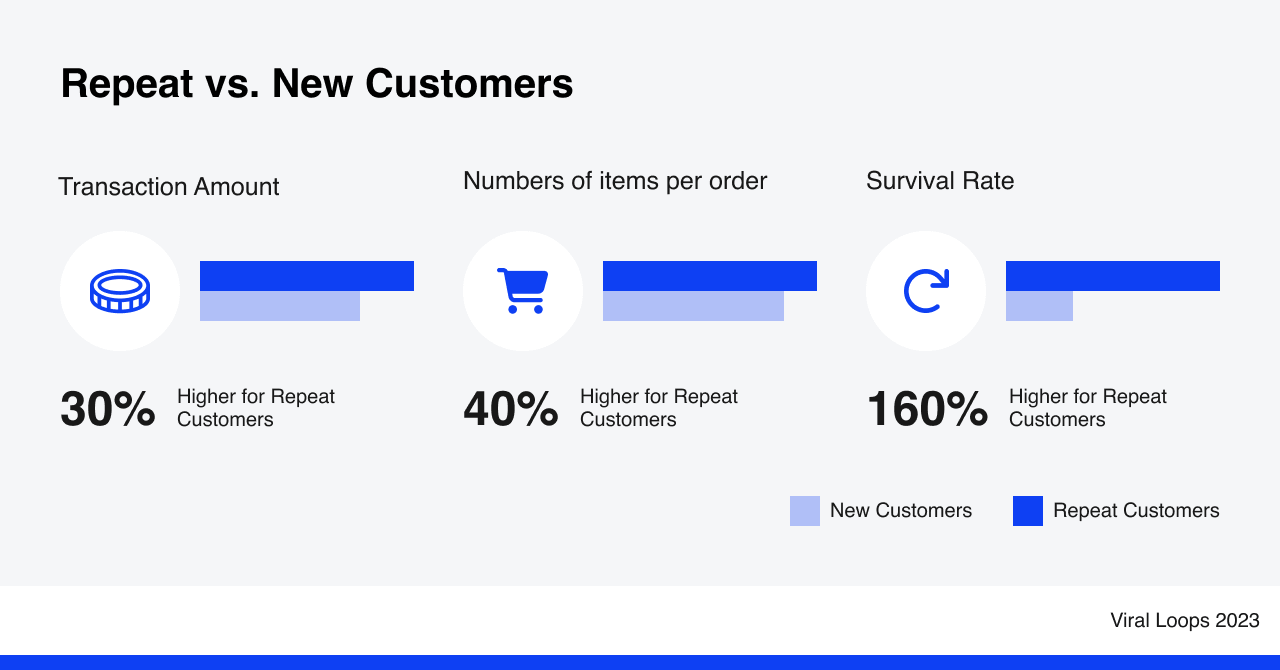
- Valuable Feedback: Loyal customers provide valuable feedback. They help you understand your strengths and areas for improvement, aiding your continual growth. They have a vested interest in your success and are often more than willing to help you improve.
Building customer loyalty is not a luxury; it’s a necessity. It’s the beacon that illuminates your path to sustainable success, fostering resilience in the face of market fluctuations.
And in this era of post-COVID economic uncertainty, being able to not just survive but thrive is necessary.
Steps to Increase Customer Loyalty
Let’s demystify the entire process of building customer loyalty from the ground up. We’ve distilled years of wisdom, industry insights, and successful strategies into these practical steps.
Understand Your Customer’s Needs
Understanding your customers’ needs is the cornerstone of any successful business.
It entails delving into the customers’ minds, identifying their desires, and aligning your products or services accordingly. For example, a fast-food chain understands that its customers value speed and convenience and, therefore, structures its service model around these needs.
Identifying the needs and expectations of your customers is a continual process. It requires active listening and observation, along with tools like surveys and customer feedback forms.
The next step is then aligning your products or services with these identified needs. This could include modifying existing products or innovating new ones to better meet their requirements.
For instance, Netflix understood an emerging customer need for on-demand video streaming, pivoted from their DVD rental model, and became an industry leader. If you didn’t know that Netflix used to be a DVD rental service, that’s because they were almost obscure then. But realizing the need for easy-to-access video content gave birth to the streaming services that we have today.
This understanding and alignment not only nurture customer loyalty but also foster a strong competitive edge, which is why Netflix is still at the top of the game despite new streaming services entering the market.
Plus, with our new feature Viral Loops Rewards, your account is fully equipped to connect and send actual rewards that fully comply with what your customer wants. Thanks to our seamless integrations with Stripe and Tremendous, sending out gifts is now a breeze. This innovative feature is just another example of how aligning with customer needs can lead to greater satisfaction and success.
Make sure to check out our Youtube video on Referral Rewards for more info!👇
Build Relationships with Your Customers
Relationship marketing strengthens customer loyalty by cultivating deep connections for long-term success.
Take Apple, for instance. They invest in their community through education, support, and updates, building trust and loyalty. Apple customers are so loyal, they eagerly await each new product release.
In fact, Apple customers are some of the most loyal out there; you wouldn’t see them within a foot of any Android device! Ok, that’s a bit of an exaggeration. Or is it?

Building customer relationships is about consistent quality and value. It requires frequent communication to understand evolving needs and meet requirements.
Utilizing the right tools is critical to building and nurturing customer relationships. Notably, social media and email marketing stand out as two of the most potent channels for this purpose.
Social media platforms such as Facebook, Instagram, and Twitter offer a dynamic space for businesses to engage with customers in real-time, share updates, and address inquiries or concerns.
On the other hand, email marketing, with its ability to deliver personalized messages directly to customers, helps maintain constant contact and keeps your brand always at the top of their minds.
Create a Superior Customer Experience
Superior customer experience is quite possibly the number one reason why customers stay, but how can you make this happen?
One is to deliver excellent customer service.
Imagine customer service as the comforting voice in the dark, ensuring customers they’re not alone. When customers reach out, they want more than canned responses. Their issues should be resolved swiftly and satisfactorily.
Think of the Ritz-Carlton’s legendary service — their employees are empowered to spend up to $2,000 to solve guest issues without any need for managerial approval. Now that’s a wow factor!
Of course, you don’t have to go that high just to make sure your customers are satisfied. The famous hotel chain did not pull this number out of thin air. It came from the knowledge that the lifetime value of each customer (CLV) goes up to $250,000.
In essence, the key here is knowing the value of each customer to you, if they remain a customer for life, and how much you are willing to spend to make them stay.
Another way to deliver a superior customer experience is to provide a seamless and pleasant customer journey. From browsing to buying and beyond, every step should be as smooth as a well-oiled machine.
The easier it is for customers to transact with you, the more likely they are to choose you over other platforms with complicated requirements and check-out options. So, if you can provide that “One-Click” checkout, don’t hesitate to do so!
Personalize Your Approach
In the era of mass-marketing, adding a personal touch can help your brand stand out. It’s like a secret handshake that makes your customers feel valued, fostering a deeper connection.
Implementing personalized marketing strategies is akin to treating your customers as individuals, not numbers. Spotify’s Discover Weekly playlist is a brilliant example.
The music streaming giant curates weekly playlists based on users’ listening habits, hitting the right chords of customer satisfaction. This bespoke approach leaves customers feeling understood, increasing their loyalty to your brand.
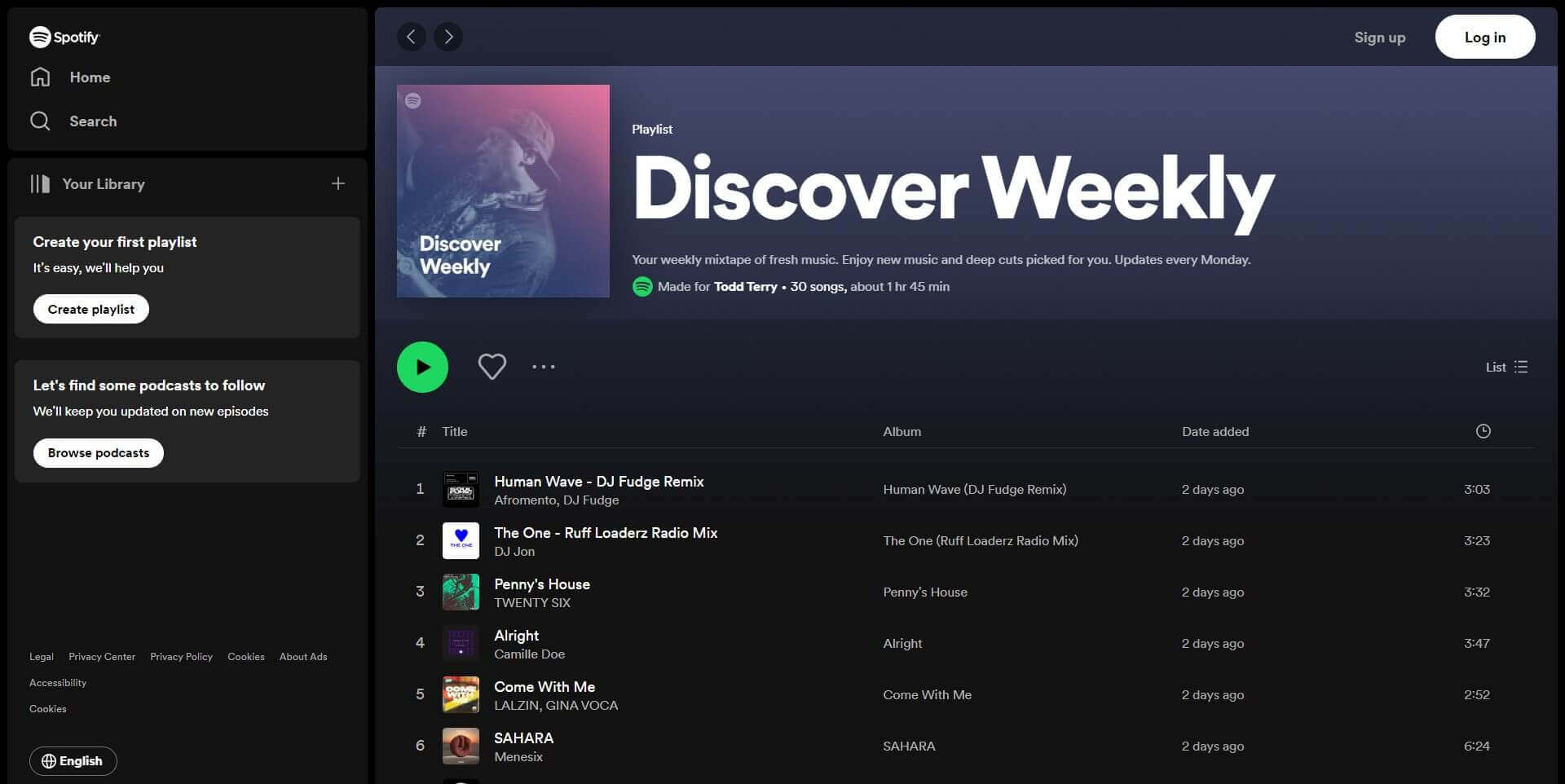
Reward Customer Loyalty
To truly promote customer loyalty, businesses must recognize and appreciate their customers’ continued patronage. Implementing loyalty and reward programs is akin to planting seeds of gratitude in fertile soil.
Consider the success of Sephora’s Beauty Insider program — it incentivizes customers with points for every dollar spent, which can be redeemed for curated gifts. This not only encourages repeat purchases but also builds a sense of belonging.
On another note, offering exclusive benefits to repeat customers is like setting the stage for an encore performance. By doing so, you’re making your customers the stars of the show.
Take the example of airlines offering priority boarding and extra legroom to their frequent fliers. These special treatments instill a sense of exclusivity, driving customer loyalty further.
Let’s dig deeper into the nuances of implementing effective loyalty and reward programs in this next section.
6 Types of Customer Loyalty Programs You Can Implement
There’s no need for businesses to break new ground when it comes to building customer loyalty programs. Like standing on the shoulders of giants, you can leverage the successful strategies others have already tested and perfected.
In this section, we’ll explore six types of tried-and-tested customer loyalty programs. These can make the path to cultivating loyal customers easier and more systematic.
We’ll add some real-life examples to inspire you and a few tools you can use to make each system work.
So, let’s dive in.
#1. Spend-Based Rewards Program
Ever heard of the phrase, “The more you spend, the more you earn?” Well, that’s precisely the concept of spend-based loyalty programs. It’s an innovative marketing strategy that rewards customers based on how much they actually spend. This is the most common type of loyalty program.
For instance, you might encounter this system in your neighborhood coffee shop where you receive a stamp for every cup of coffee purchased. Once you’ve collected a certain number of stamps, you can exchange them for a free coffee or get a free upgrade.
The beauty of this system lies in its simplicity — the more a customer spends, the more they are rewarded. This encourages repeat purchases and strengthens customer loyalty.
Implementing Spend-Based Loyalty Programs
Implementing a spend-based loyalty program can be as simple as pie.
Start by deciding on a suitable reward-to-spend ratio. You can’t just randomly choose a reward. You have to predetermine the amount that still leaves room for profit, while still making it high enough to convince your customers.
The magic happens when your customers feel they’re getting more bang for their buck.
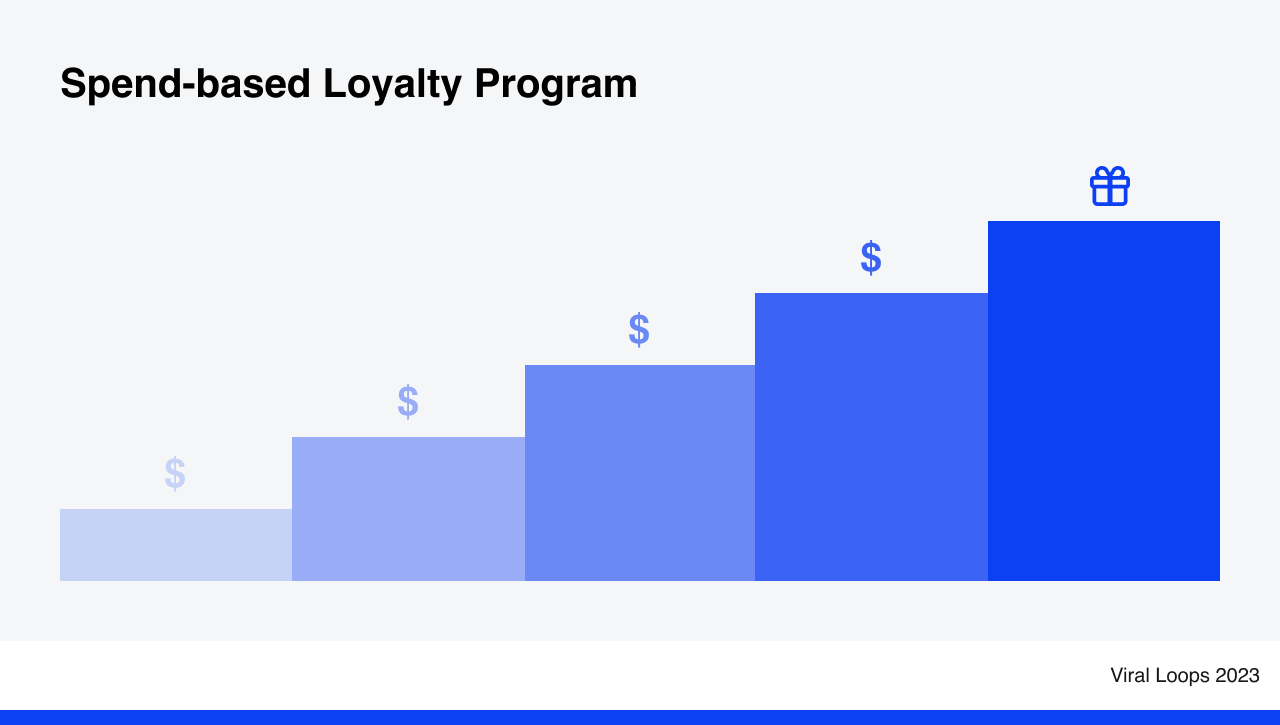
Real-life Example: Target’s Circle
Target hit the bullseye with its Circle loyalty program. It’s a stellar example of a spend-based rewards system. For every buck you spend, you score 1% in rewards.
What’s more is that they take personalization to a whole new level. How so? They provide special birthday treats and personalized deals — all tailored to your shopping habits. So you’re not just a number on a spreadsheet. You’re a valued customer. A real person.
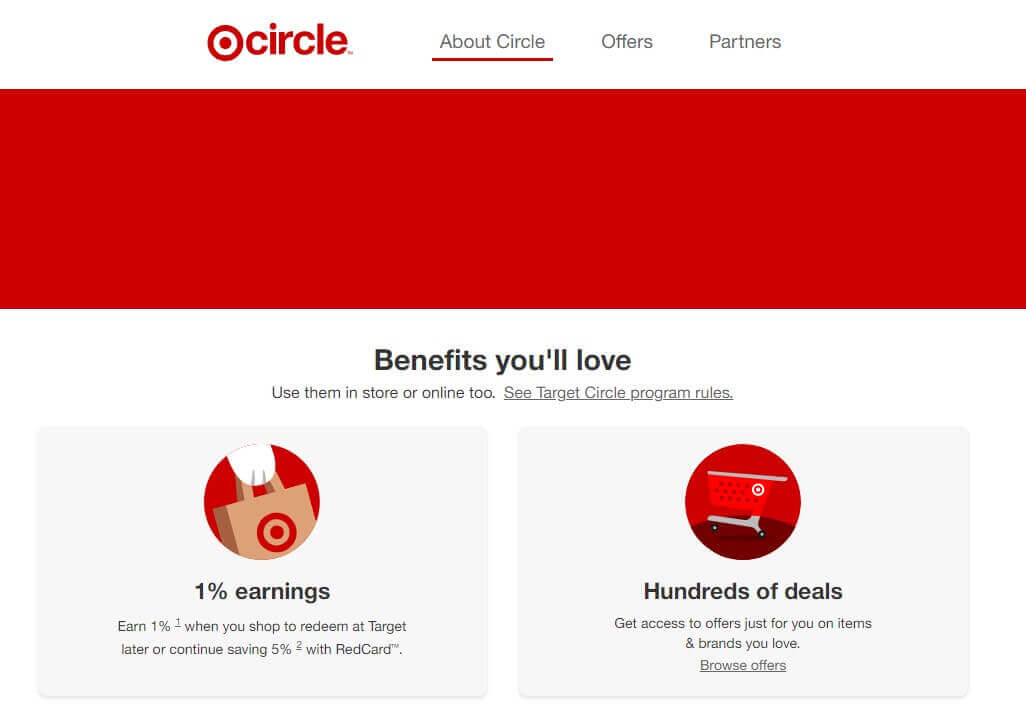
Tools for Spend-Based Loyalty Programs
When it comes to launching and managing spend-based loyalty programs, you don’t need to worry. Being one of the most popular programs means that almost all apps and tools out there offering loyalty programs have this option.
#2. Tiered Loyalty Programs
Now imagine a world where the more you engage, the more you’re recognized. That’s tiered loyalty programs for you.
It’s a loyalty system that rewards customers not just for buying but for engaging. You know, like attending events, sharing social posts, or referring friends. The more a customer engages, the more rewards they rack up.
To put it in a nutshell, the beauty of tiered loyalty programs is that they offer the thrill of progression. As a customer crosses certain thresholds of spending or engagement, they unlock an abundance of new perks and benefits.
It’s like advancing to the next level in a game: the rewards get bigger and better.
This system not only induces a sense of achievement but also incites anticipation for the next round of rewards. Hence encouraging customers to spend more, engage more, and ultimately, stay loyal to the brand.
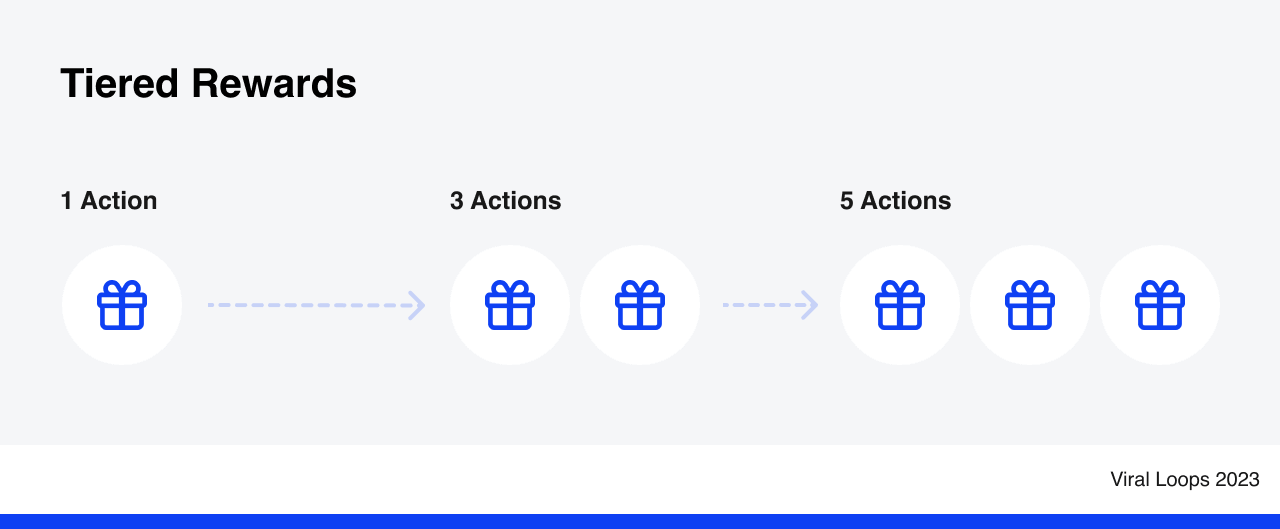
Implementing Tiered Loyalty Programs
If you’re sold on the idea and eager to introduce a tiered loyalty program, then let’s break it down into manageable steps.
Start by defining what engagement means for your brand. It could be purchases, referrals, or social shares.
Next, define how many tiers you want to have. Keep in mind that more tiers don’t mean more engagement. On the contrary, it only shows that the top tier may just be too out of reach that some customers would be turned off and would rather not participate.
Around 3 to 5 tiers are ideal.
Next, establish the reward tiers based on levels of engagement or purchases. Make sure the top tier is tempting but achievable.
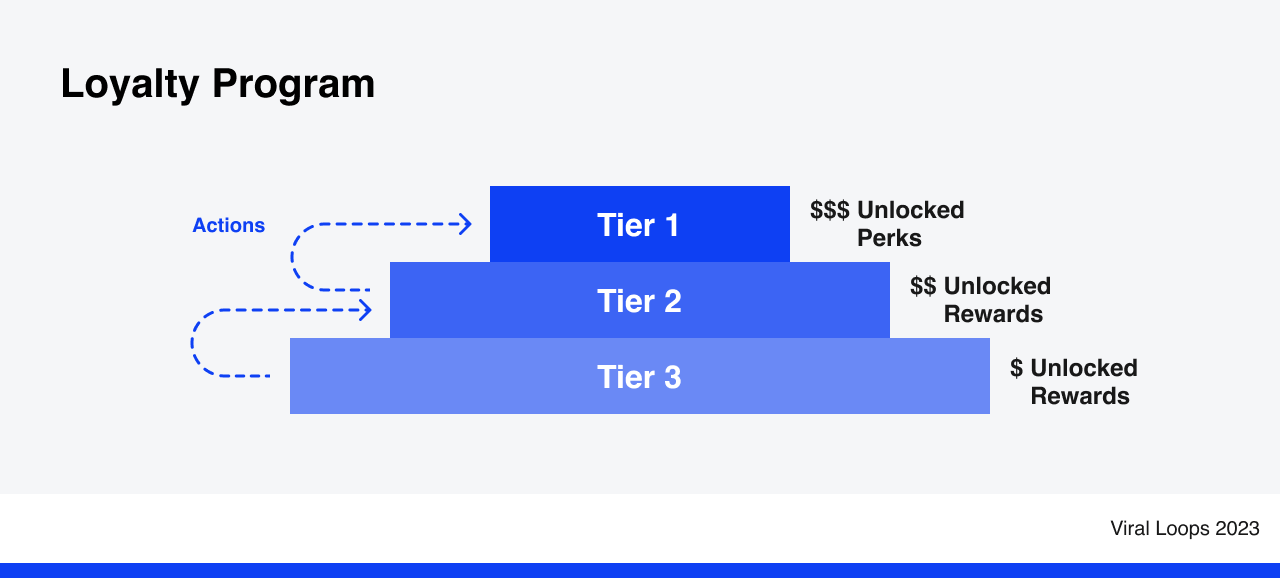
Real-life Example: Sephora’s Beauty Insider
We’ve already mentioned Sephora above, but let’s dig deeper into its tiered loyalty program.
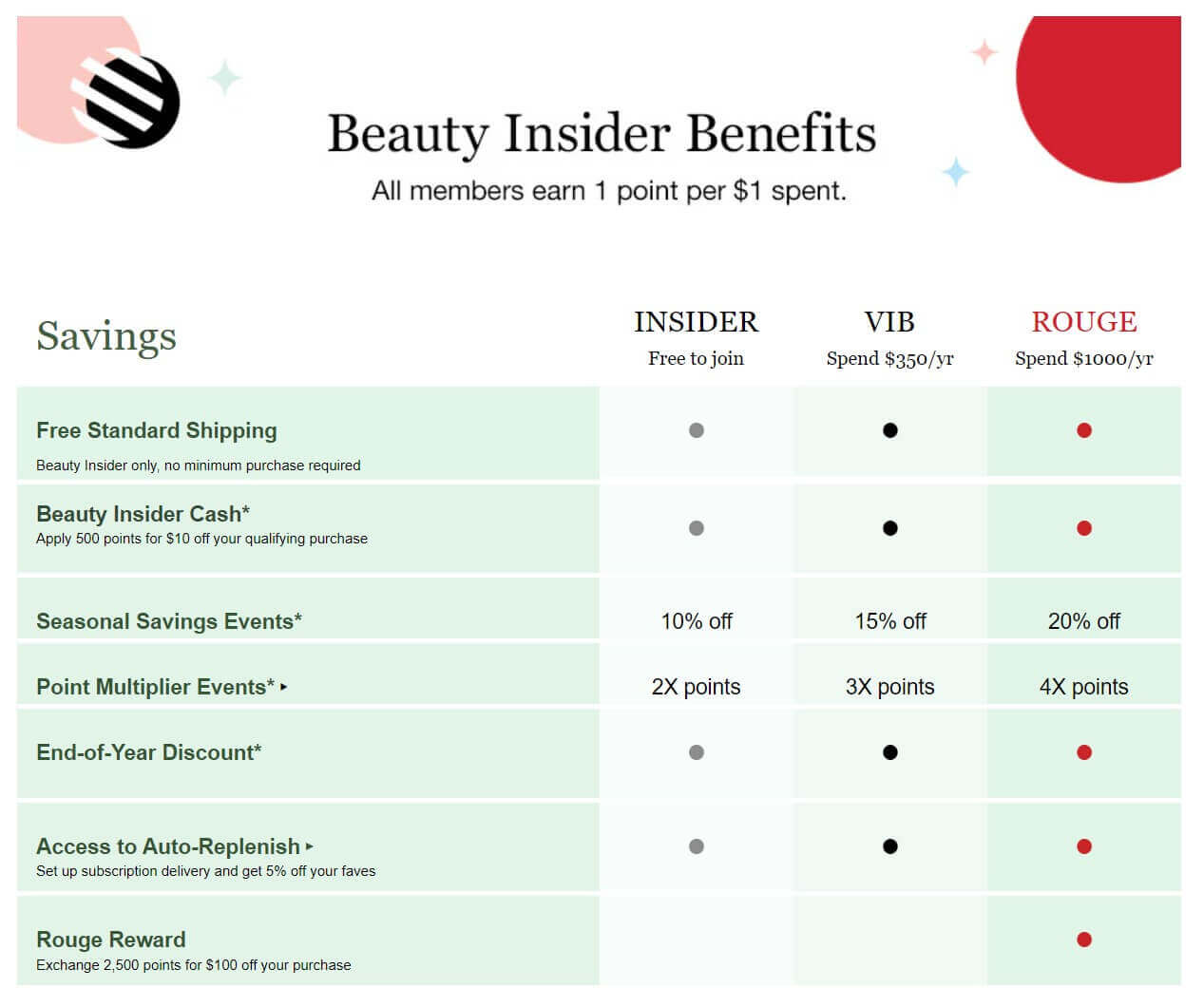
You start as a Beauty Insider, which is free to join. You’ll get free standard shipping, Beauty Insider Cash (points convertible to cash), seasonal savings, a free birthday gift, and more.
The next level up is Very Important Beauty Insider (VIB) status. To reach this tier, you need to spend $350 in a calendar year. VIB members not only receive all the benefits of Beauty Insiders but also enjoy additional perks like 1.25 points for every dollar spent, full-size products, and special gifts each year (on top of the birthday gift).
The most elite of the levels is Rouge, which requires $1,000 in annual spending. Rouge members receive 1.5 points for every dollar spent, free shipping on all orders, exclusive access to events and private sales, and surprise custom makeovers.
As you can see, Sephora has mastered the art of tiered loyalty programs by offering enticing rewards at each level. The exclusive events alone would make you want to reach the top tier.
Tools for Tiered Loyalty Programs
When implementing tiered loyalty programs, one standout tool to consider is LoyaltyLion.
LoyaltyLion is a distinctive platform known for its flexibility and scalability. It offers a fully customizable tiered loyalty program that can be tailored to fit the unique needs of your business.
With it, you can set up different tiers, define specific rules for moving up the tiers, and design exclusive rewards for each level.
#3. Value–Based Loyalty Programs
When it comes to keeping customers hooked, value–based loyalty programs are the bee’s knees. These programs reward customers for behaviors that reflect the brand’s values.
We’re not just talking about purchases, but actions like recycling packaging or sharing eco-friendly posts online. These programs are game-changers as they create an emotional bond between the brand and the customer.
Implementing Value–Based Loyalty Programs
If this is the kind you want to work with, then start with your brand values. What’s important to you? Sustainability? Community outreach? Identify it.
Next, think about actions that reflect those values. Maybe it’s sharing a sustainability tip or volunteering in your community. Decide what actions will earn points and how these can be monitored.
Now, create a rewards system that also reflects the values you are promoting. It could be a discount on an eco-friendly product or a reusable item as a gift. Even the fact that they can participate and be touted on your social media pages is a reward in itself.
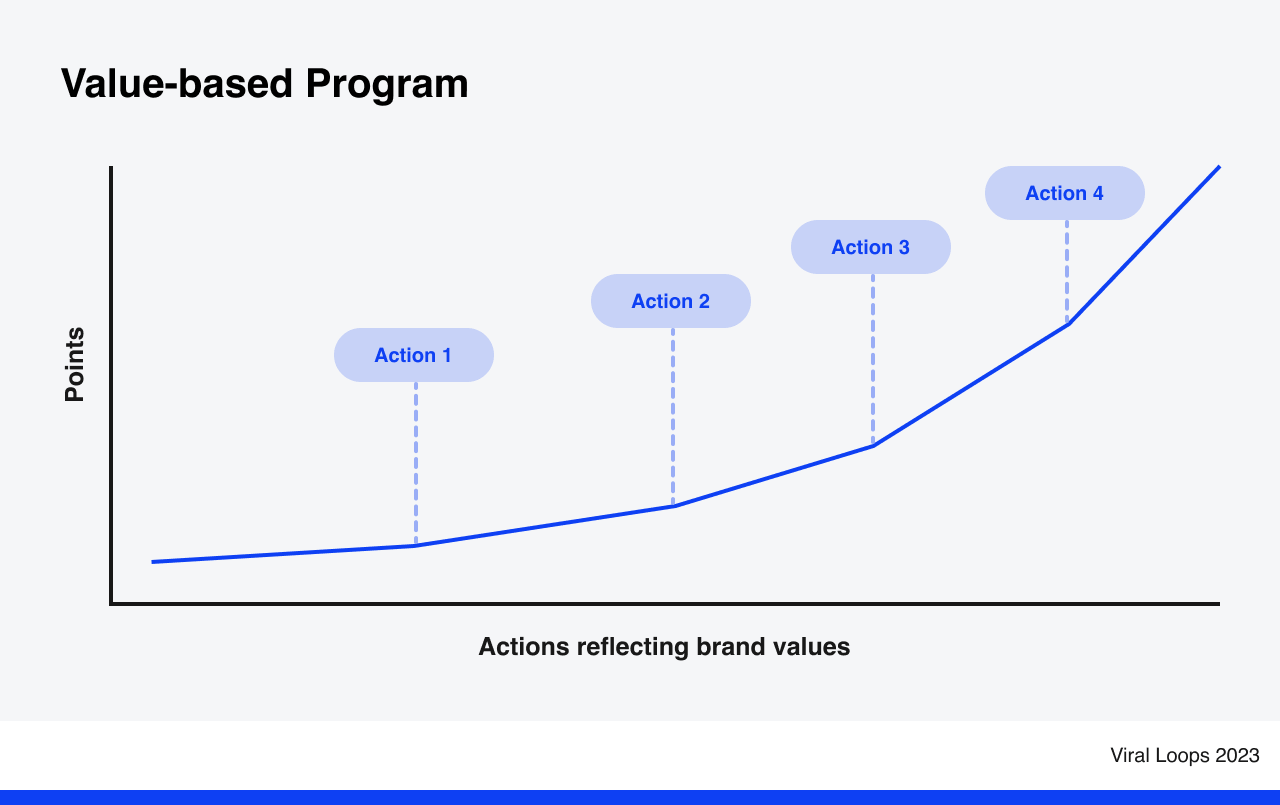
Real-Life Example: REI Co-op
Take a page out of REI Co-op’s playbook. Their loyalty program is a perfect example, as they reward members for making sustainable choices.
You heard me right. REI gives points for eco-friendly purchases. Buying biodegradable camping gear or joining cleanup events? You just scored. And it doesn’t stop at products. REI members can earn points by opting for a digital receipt instead of printing one, recycling packaging materials in-store, and more.
Moreover, the rewards themselves are centered around sustainability. Members can redeem points for discounts on eco-friendly products or even donate their points to environmental causes.
So, why does this work? It’s simple. REI and its customers share a common goal: sustainability. The program is a reflection of this shared value, uniting customers and the brand in a single cause.
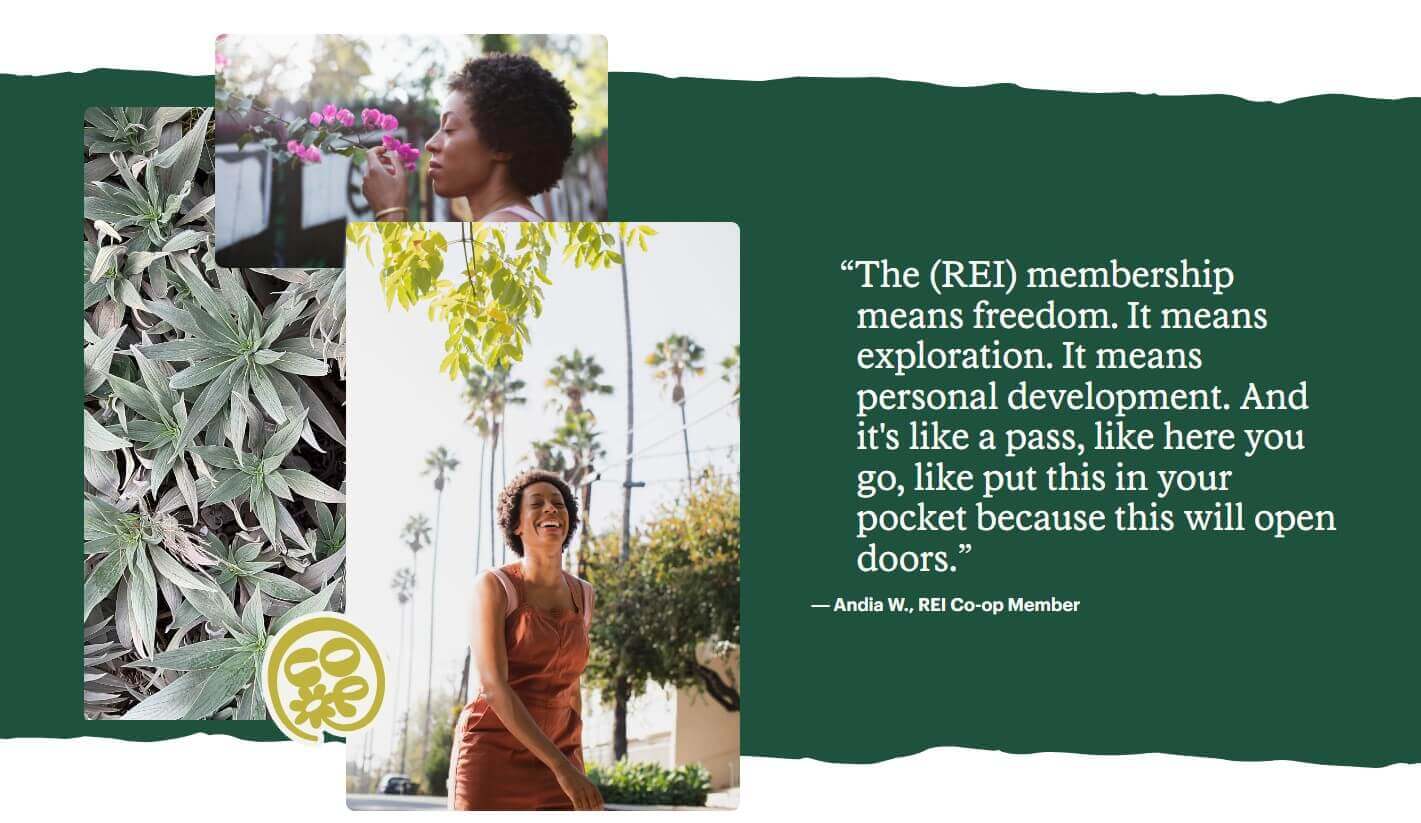
Tools for Value–Based Loyalty Programs
A couple of tools offering value-based programs are Antavo and Loyalty Gator.
Antavo is a loyalty management platform built for the new era of retail. It’s all about creating loyalty programs that focus on customer retention and brand values.
Then there’s Loyalty Gator. It offers easy-to-use tools to create a custom program that’s just right for your business. You can’t go wrong with either.
#4. Gamified Loyalty Programs
Imagine transforming customer loyalty into a thrilling, interactive challenge.
Sound exciting? That’s gamified loyalty programs for you!
It’s the process of adding game design elements to loyalty programs, creating an engaging, fun experience. This makes it stand out from your typical points-for-purchases system.
The allure of gamified loyalty programs stems from several innate human tendencies. The thrill of earning rewards, an inherent sense of competition, and the perpetual dread of missing out on exclusive benefits all fuel the customer’s engagement in these programs.
Encased in a fun and interactive package, these elements work together to elevate the appeal of gamification in loyalty programs.
Implementing Gamified Loyalty Programs
The key to implementing gamified programs is to start by identifying key behaviors you want to reward. It could be anything from social shares to store check-ins to playing actual games on your website or app.
Next, consider what game elements will motivate your customers. Maybe it’s badges for milestones, leaderboards for competition, discounts, or unlocking exclusive rewards.
Then, set your rules. How does one earn a badge, climb the leaderboard, or earn a reward? Keep it simple, clear, and fair.
Unlike tiered loyalty programs, where you should limit the levels to a maximum of 5, you can have several levels for your gamified program. This ensures the continued participation of your customers.
If you can create a leaderboard of top participants — even better! This encourages users to keep trying so that they, too, will be given their time in the spotlight.
Of course, to have an end in sight, you should set up the top “rung” of your gamified program. Or you can set up a finale event to wrap up each program. Just make sure that every time an event or a program ends, you already have another one in place to keep customers coming back.
Real-Life Example: Nike+
One exemplary implementation of gamified loyalty programs is the Nike+ platform by Nike, a well-established brand. Nike+ is a multi-faceted program that rewards customers not just for purchases, but for engaging in physical activities and using Nike’s suite of digital fitness tools.
Members earn points (or “Fuel,” in Nike+ parlance) for activities tracked through the Nike+ app—running, exercising, even playing sports. These points can then be redeemed for exclusive Nike products or experiences only available to Nike+ members.
In essence, Nike+ turns fitness into a game, where every step, every mile, every workout is a chance to level up.
Beyond the excitement of earning points, Nike+ also fosters a sense of community among its members. The platform features leaderboards where members can compare their progress, fostering a sense of competition and camaraderie. Exclusive events and challenges further gamify the Nike+ experience, with members vying for leaderboard dominance or completing unique challenges to unlock special rewards.
Even though Nike is already a household name, the Nike+ program is a powerful tool in ensuring the brand stays at the forefront of consumers’ minds. It serves as a constant reminder of the brand’s presence, not just when consumers are buying athletic gear, but when they’re out living active, healthy lifestyles.
This compelling combination of gamification and value-creation truly sets Nike+ apart, cementing Nike’s position at the “top of minds” in its market.
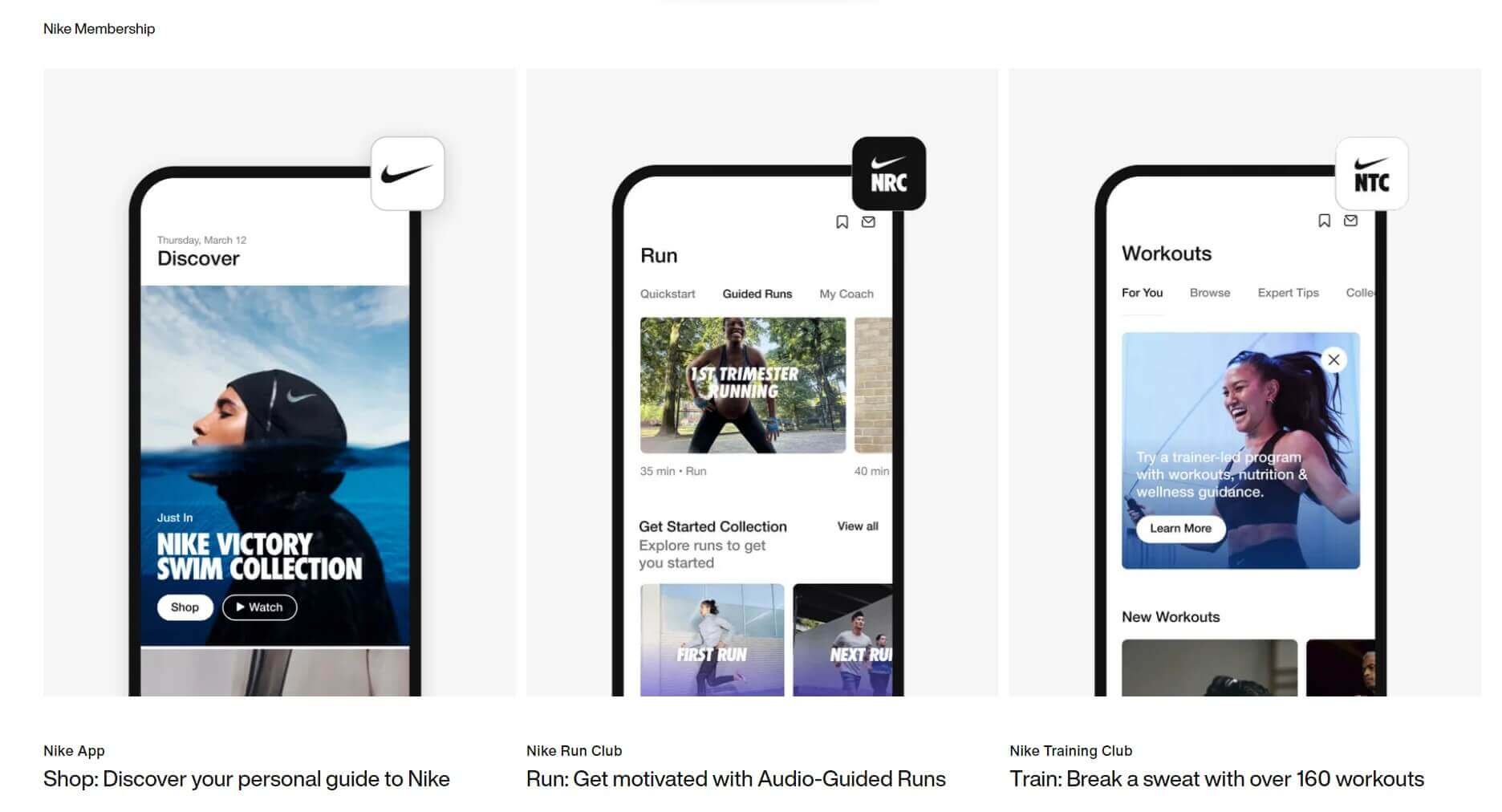
Tools for Gamified Loyalty Programs
Now, let’s talk tools. OpenLoyalty is one service aimed at helping businesses build their gamified loyalty programs. It offers a customizable platform with various game mechanics to choose from, like leaderboards, badges, and points.
Another option is Bunchball, a gamification platform that allows businesses to create personalized challenges, competitions, and achievements for their customers.
#5. Paid Programs/Membership Loyalty Program
Fee-based loyalty schemes, or as we like to call them, Paid Programs, are the VIP lounges of customer loyalty.
Ever thought about why clubs have velvet ropes and bouncers? Exclusivity, baby! It’s alluring, and it makes people want in.
Paid programs hinge on this principle. Customers pay a fee to unlock exclusive perks.
It’s different from your run-of-the-mill points system. Why? Because it’s about more than transactions, it’s about making the customer feel special.
But why would anyone cough up cash for a VIP club? It’s simple. The benefits outweigh the cost. VIPs get the red-carpet treatment with priority access, exclusive deals, and primo customer service.
It may come as a surprise, but members of paid loyalty programs are 60% more likely to purchase more from the brand than those who became part of a free loyalty program.
Implementing Paid Programs
Here’s how to get started with paid loyalty programs.
First, set a membership fee. If you just want to target your big spenders, then you can opt for a higher fee. Whatever the amount is, it should be reasonable enough for the kind of customers you have or want to use this loyalty program for.
The next step is to decide what perks to offer. Exclusive discounts, free shipping, early access to new products, or priority customer service are just a few options. Be creative! You want these benefits to feel exclusive and valuable.
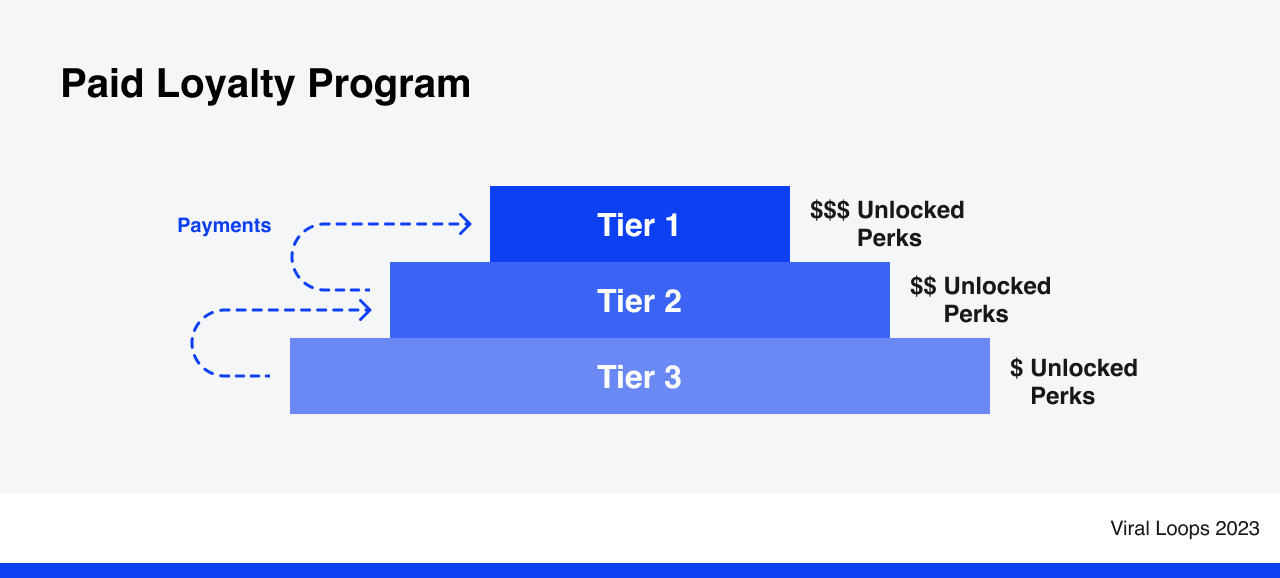
Real-Life Example: Amazon Prime
Amazon Prime’s success is undeniable, making it a prime (pun intended) example of a paid loyalty program.
Customers pay a monthly fee ($14.99 per month in the US, but the price varies per location). In return, they reap a cornucopia of benefits, which include:
- Prime Video
- Prime Music
- Prime Gaming
- Prime Reading
- Amazon Photos (storage)
- Free shipping on countless items.
- Same-day delivery on select products.
Amazon Prime’s success hinges on several factors. First, the breadth of offerings. It’s not just about shipping. Music, video, grocery delivery services, and more add value.
Second, the ease of use. Users can access all services and benefits under one account.
Finally, constant innovation keeps members engaged. From drone deliveries to collaborations with popular brands, Amazon keeps the surprises coming.
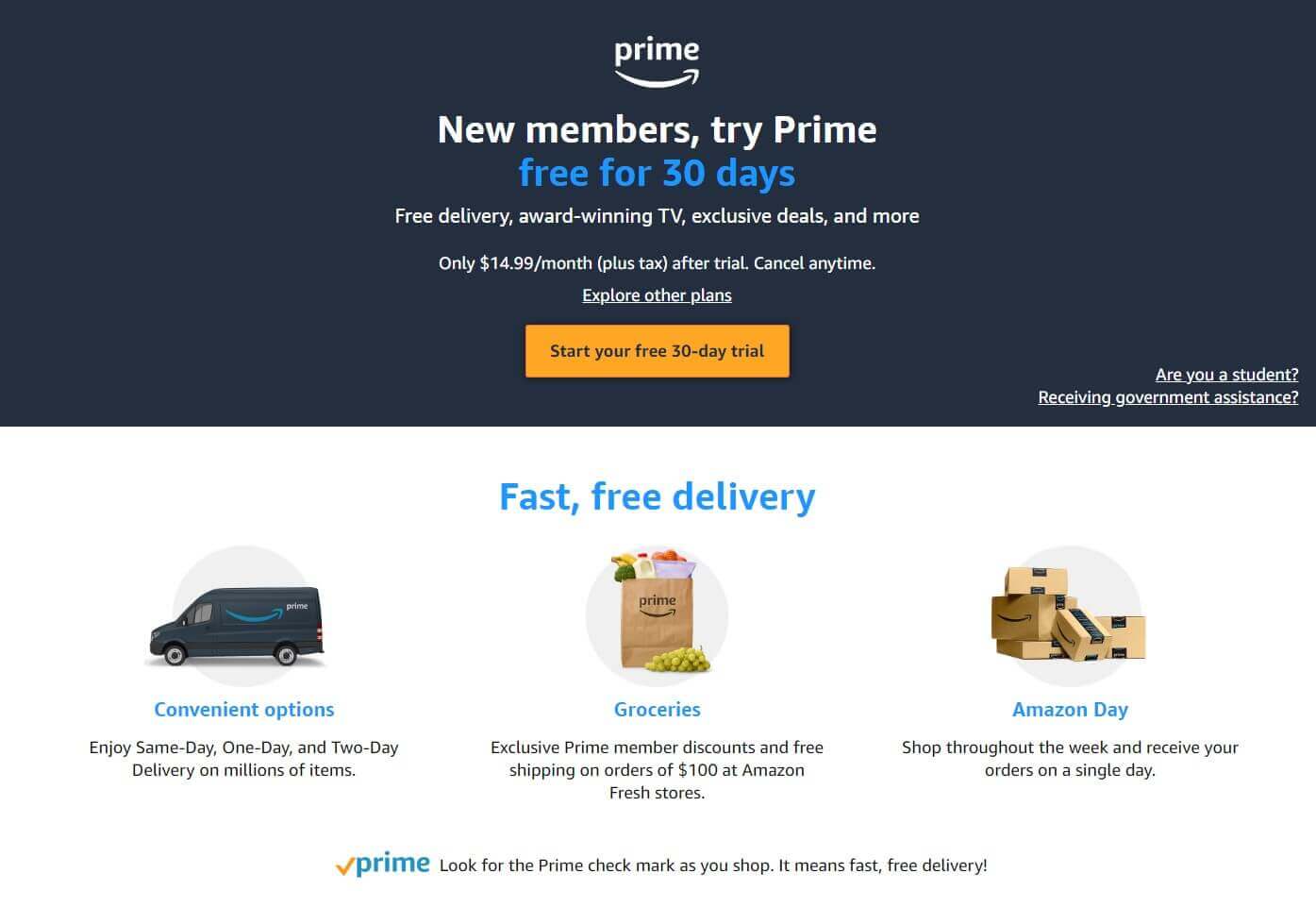
Tools for Paid Programs
Antavo is an exceptional platform that enables businesses to set up effective paid loyalty programs. It offers a comprehensive suite of tools, making the creation, implementation, and management of a paid program significantly more manageable.
The platform’s flexibility allows businesses to tailor a loyalty program that aligns perfectly with their brand and market demographics.
#6. Referral-Based Customer Loyalty Programs
Referral-based loyalty programs are like the ultimate social proof on steroids. It functions not just to gather leads, but as another customer touchpoint. This helps existing customers stay engaged with your brand even when they’re not making a purchase.
These programs are a different breed, focusing on incentivizing word-of-mouth marketing rather than rewarding transactions or fees. It’s all about empowering your customers to turn into brand ambassadors.
Why would anyone choose to take part here? Simple.
Referral programs often carry a dual incentive structure. This means both the referrer and the referral get rewarded.
Referrers score sweet rewards and feel good about sharing the business with their friends. The referrals get to discover a rad brand and snag a reward on their first purchase.
Implementing Referral-Based Customer Loyalty Programs
To implement a successful referral program, start by defining the incentives. They should be enticing enough to motivate your loyal customers to refer others.
This could be a discount, a free product, or exclusive access to new features. You can even set up Milestone referrals so that the referrer can get better rewards if they refer more people.
Next, decide who’s rewarded. Just the referrer? Maybe both parties (recommended)?
Integration is also crucial. Your referral program should blend seamlessly with your other business operations and customer touchpoints. It should feel like a natural extension of your brand rather than an out-of-place add-on.
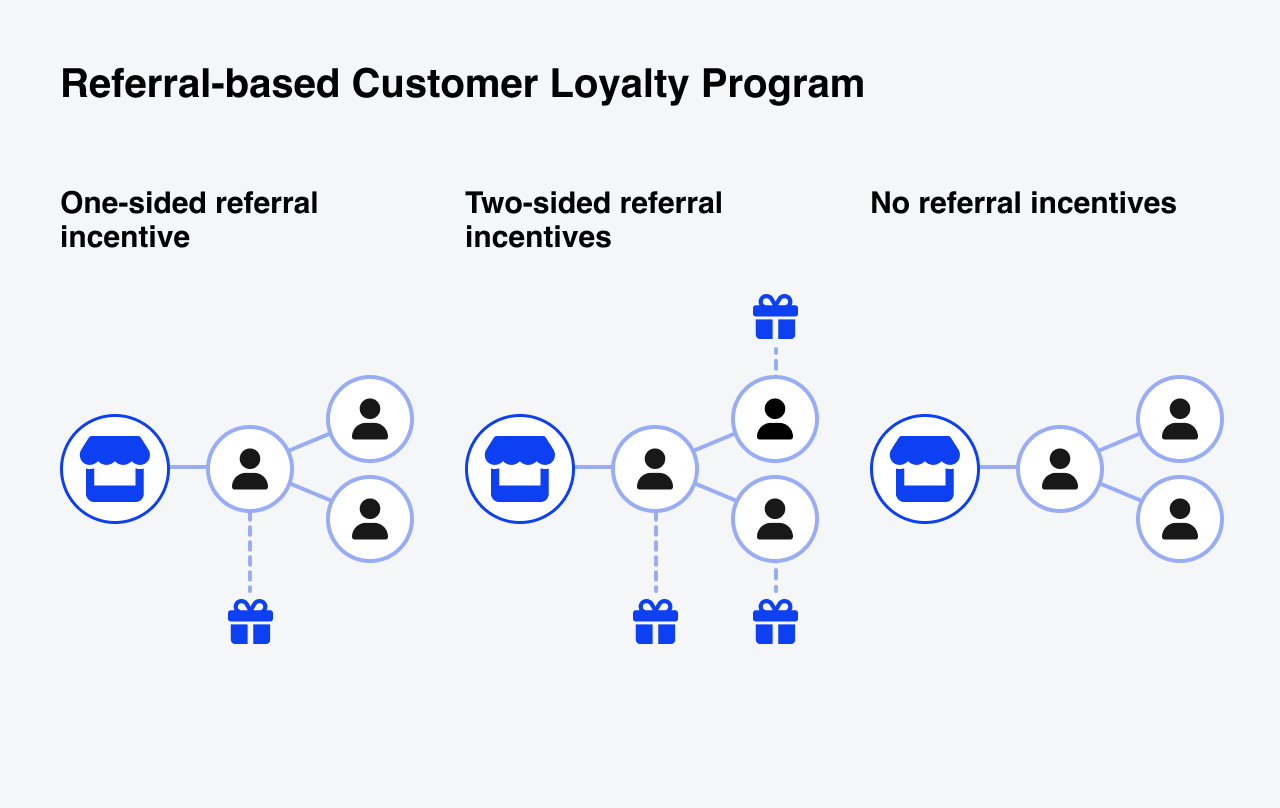
Real-life Example: American Express’ Referral Program
American Express’ referral program masterfully fuels customer loyalty.
High rewards serve as a potent motivator. They keep members buzzing, actively spreading the word about the brand. This, in turn, sets up an engaging, dynamic relationship between the customer and the company. It’s more than just loyalty; it’s participation.
By rewarding members even when their referrals opt for a different credit card, American Express acknowledges personal preferences. This flexibility, paired with high rewards, is a winning combination. It keeps customers feeling valued and understood, sparking a sense of loyalty that’s hard to shake.
Furthermore, the generous limit on maximum points that can be accumulated per year seals the deal. It propels customers to continue referring. This constant engagement keeps American Express at the forefront of their customers’ minds.
It’s a clever strategy: it provides continuous touchpoints for existing customers, further cementing loyalty, and it helps gain new customers in the process.
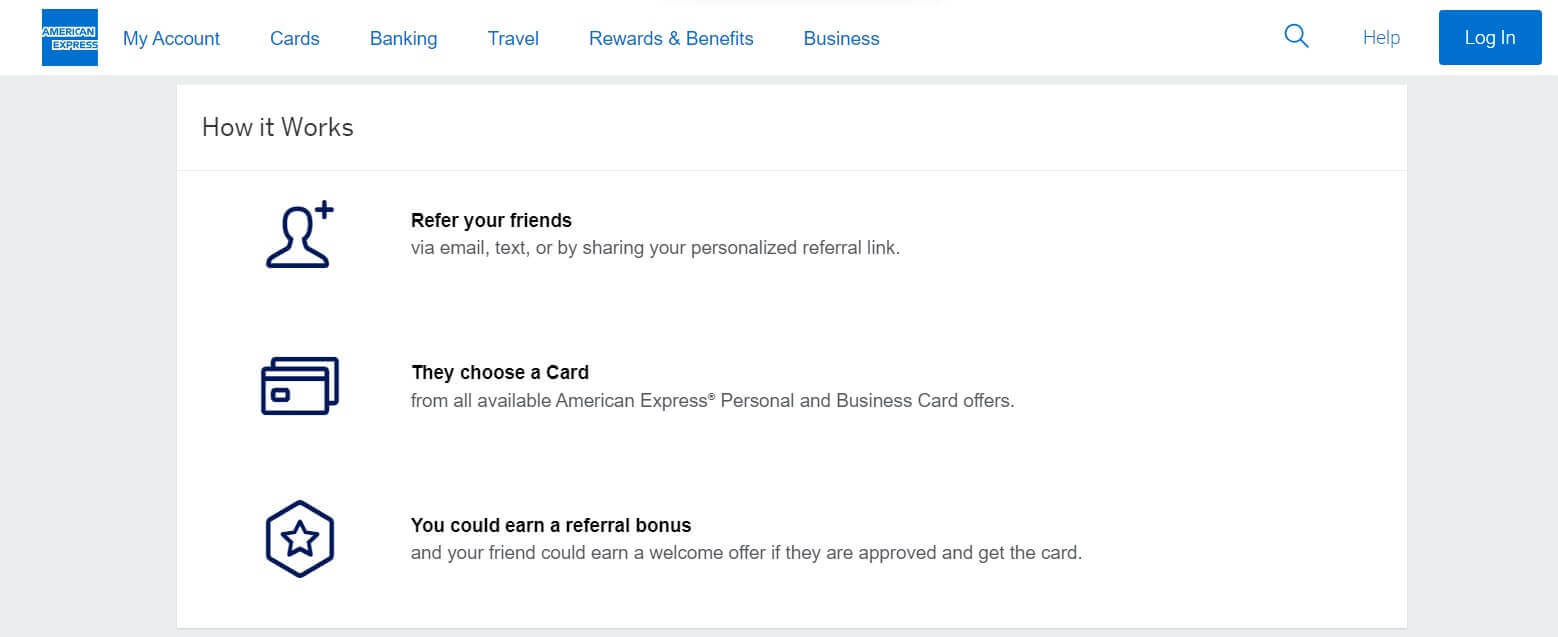
Tools for Referral-Based Customer Loyalty Programs
Viral Loops is a powerful and versatile platform for creating referral-based customer loyalty programs. With a range of referral options, such as the Milestone Referral, which offers tiered rewards based on the number of successful referrals, and Leaderboard Referral, which introduces a competitive element, it’s an excellent choice for businesses looking to boost customer engagement and loyalty through referrals.
Beyond its offering of diverse referral options, Viral Loops also shines in its analytical capabilities. It provides a comprehensive suite of analytics tools that allows you to track the performance of your referral campaigns, monitor progression, and adjust strategies as necessary to maximize results.
In essence, Viral Loops is a robust solution for businesses looking to harness the power of referral-based customer loyalty programs. Want to see it in action? Why not book a demo today? Discover the power of referral-based customer loyalty programs and witness firsthand how Viral Loops can transform your business.
How to Evaluate Customer Loyalty
After the dust has settled, it’s time to evaluate the success of your customer loyalty programs. This is crucial as it lets you know whether the system you launched is delivering as expected. Plus, it reveals areas needing improvement.
One key thing to remember though is that before you even launch your loyalty plans, make sure you have baseline data that you can compare your performance with.
Here are some of the key metrics you should look into when evaluating customer loyalty:
1. Repeat Purchase Rate
As its name implies, it measures the frequency at which customers return to make another purchase. A surge in frequency signals stronger loyalty. A decline, however, could indicate dissatisfaction.
Analyzing this metric involves a close look at the purchase history. It requires the calculation of the proportion of customers who have purchased more than once within a defined period.
This in-depth analysis unveils patterns and trends in repeat purchasing behavior, offering businesses a chance to understand their customers better.
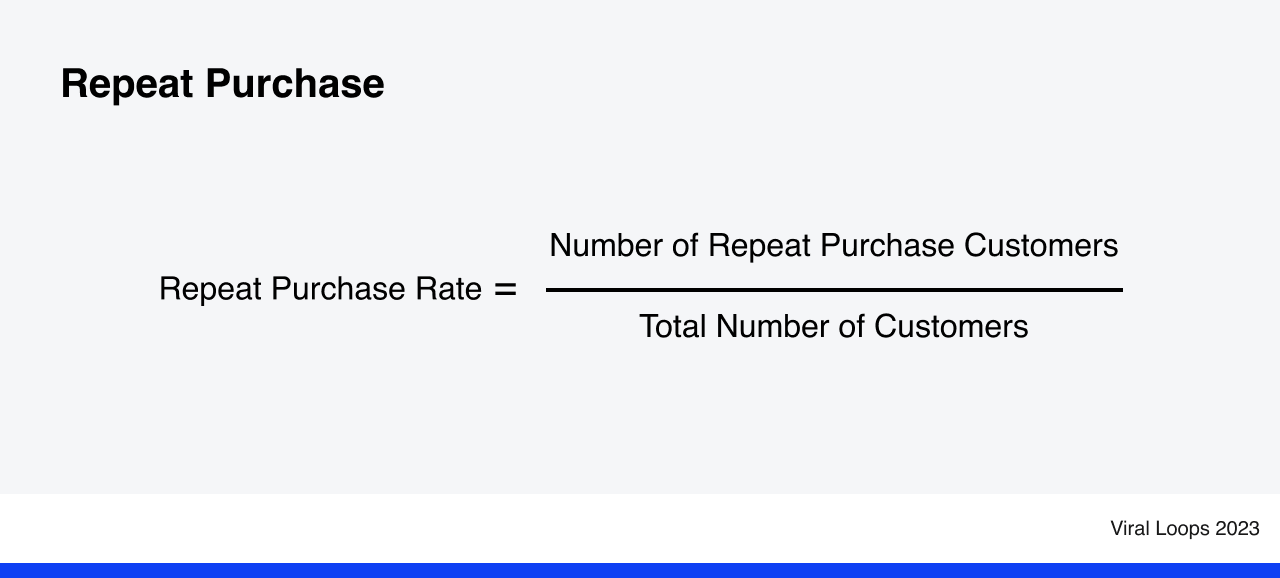
2. Customer Lifetime Value
Customer Lifetime Value (CLV) is a critical metric that estimates the total revenue a business can expect from a single customer account.
It considers a customer’s revenue value and compares that number to the company’s predicted customer lifespan. Businesses use this calculation to identify significant customer segments that are the most valuable to the company.
CLV plays a fundamental role in evaluating customer loyalty as it helps businesses understand the financial value of each customer.
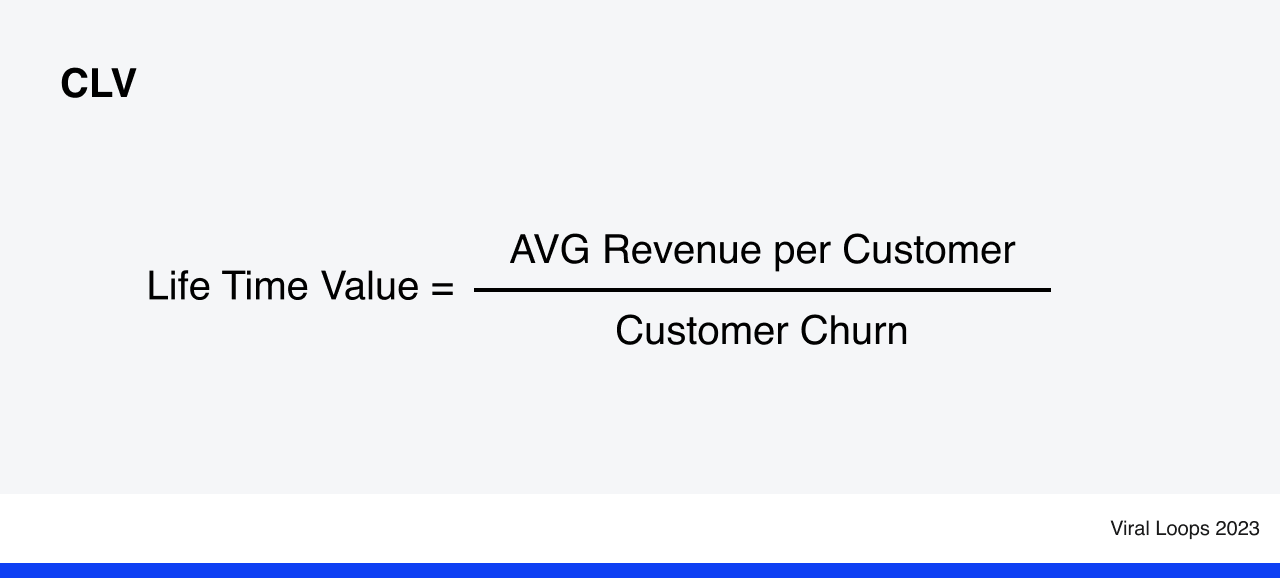
A high CLV indicates high customer loyalty, as customers are consistently engaging with the company and its products or services.
Assessing this also allows companies to refine their marketing strategies. By recognizing the customers who bring in the most revenue, businesses can target their marketing efforts and resources more effectively, ensuring the most loyal customers receive the attention they deserve.
3. Net Promoter Score
The Net Promoter Score (NPS) stands as a vital metric to gauge customer loyalty and the effectiveness of all your customer-related programs. NPS measures customers’ satisfaction with your company, as well as their willingness to recommend you to others.
To calculate NPS, you ask customers one simple question: “On a scale of 0-10, how likely are you to recommend our company to a friend or colleague?”
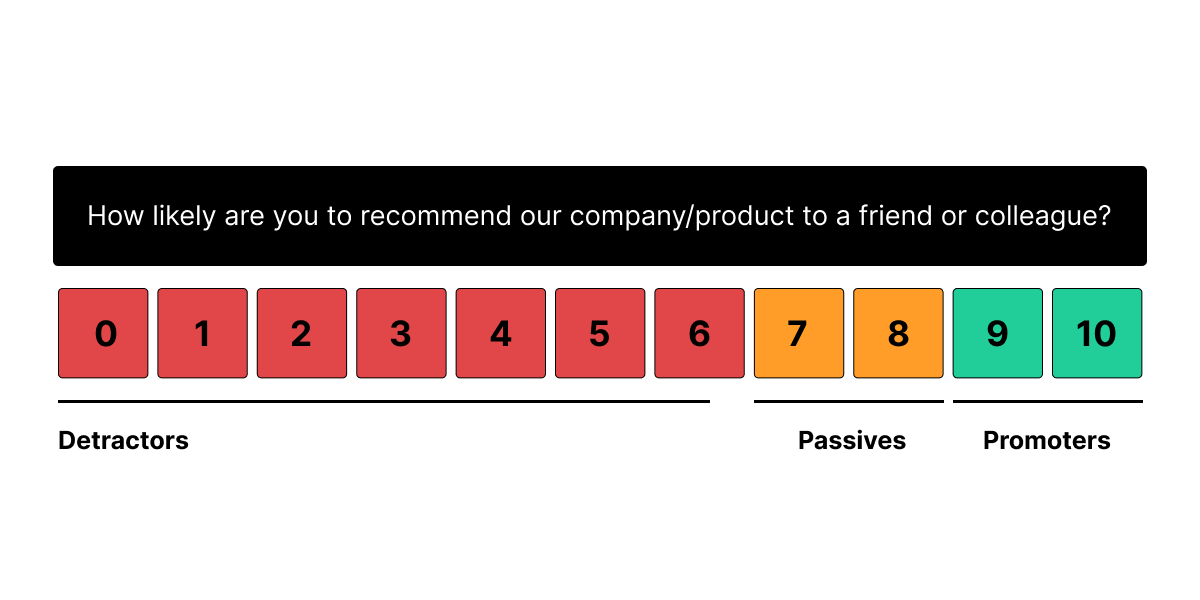
Scores of 9 to 10 are Promoters, those who are loyal enthusiasts likely to fuel growth through repeat purchases, referrals, and positive word-of-mouth.
Scores of 0 to 6 are Detractors, who may be unhappy customers at risk of churn and negative word-of-mouth.
Those who score 7 to 8 are Passives, satisfied but unenthusiastic customers who are vulnerable to competitive offerings.
The NPS is calculated by subtracting the percentage of Detractors from the percentage of Promoters. This score can range from -100 (all Detractors) to +100 (all Promoters), providing a clear and comprehensive view of customers’ perception of your brand.
4. Redemption Rates
Redemption rates serve as direct indicators of the effectiveness of your loyalty program. This metric quantifies the percentage of customers who have redeemed the rewards they’ve acquired through your program.
A high redemption rate signifies that customers find value in your rewards, indicating that your loyalty program is achieving its intended purpose.
However, while redemption rates are undeniably important, it’s crucial to delve deeper into customer behavior post-redemption. Specifically, businesses should be tracking the rate at which customers who redeemed rewards make subsequent purchases. This long-term effect is an often overlooked, yet critical aspect of assessing customer loyalty.
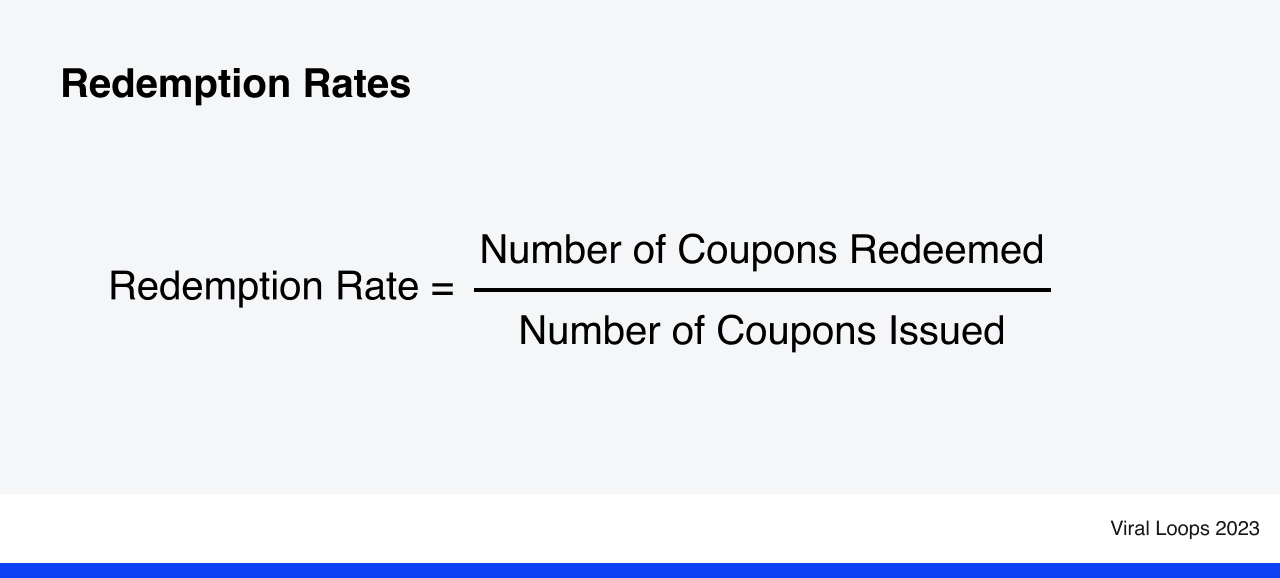
If a significant number of customers who redeem rewards continue to make purchases, it suggests that the initial reward redemption is fostering a longer-term engagement and loyalty.
However, if many customers stop purchasing after redeeming their rewards, it may indicate that the rewards are not incentivizing the sustained engagement that a successful loyalty program should stimulate.
Customer loyalty doesn’t exist in a vacuum; it’s a dynamic process that hinges upon continuous improvement. As such, all businesses should make a conscious effort to revise, refine, and optimize their customer loyalty strategies based on both quantifiable and qualifiable results.
Final Thoughts
In the world of customer loyalty, remember this: The best way to a customer’s heart is not through their wallet, but through actions and strategies that show you recognize and value them. Treat this as your compass, guiding all your customer loyalty programs.
Remember to go above and beyond to exceed their expectations, offer personalized experiences, and deliver exceptional customer service. By building genuine connections and fostering trust, you can create a loyal customer base that will not only return but also advocate for your brand.
